少林功夫
少林功夫(绝技)图解——铁头功

铁头功来源:全球功夫网作者:韩峰(整理编辑)日期:2009-9-28 点击: 2570次武术专家指导:全球功夫网CEO、北京少林武术学校总校长兼总教练傅彪武术专业演示:总教练傅彪与得意弟子/韩峰摄影:博文、李倩、萧光、邱永旗、傅雷【经典武姿】上图为北京少林武术学校总校长兼总教练傅彪演示(铁头断石板)(摄于2008年6月6日)【功法简介】铁头功,为硬功外壮,属阳刚之劲,兼内壮之气。
铁头功分顶门、前额、后脑三部,虽用外壮之力坚其筋骨,然亦须运用身内之力、气、神充满脑房,互相为用,始克有成。
否则,徒恃外壮之力,而无内壮之劲,则虽能成,亦属下乘。
【功法修炼原则】本功法练习过程要由浅入深、从易到难、由软到硬的原则去习练。
不可急于求成,要循序渐进。
【练习步骤】第一阶段1.初练之时,因脑骨尚未坚而脑易伤,须由软到硬练习,先在沙袋上练之,要由轻到重,按照步骤练习,不可盲目习之,否则易受损伤。
习练时须提气充脑,每日行若干次。
初时不可猛力顶撞,须练习稍久再逐渐加重,而顶撞之次数,亦随之增加。
勤习一年,初步功成(图1--图4)。
(图1)韩峰演示(图2)韩峰演示(图3)韩峰演示(图4)韩峰演示2.然后再以头与树木直接顶撞,首先由轻到重,初时亦颇痛苦,行之日久,逐渐不觉,此阶段须苦练一年方可(图5--图6)。
(图5)傅彪演示(图6)傅彪演示第二阶段此阶段可由树桩改为石砖或墙壁练习,其练法要遵照功法原则习练,每天习练一个时辰,训练强度因人而异,(图7--10)。
(图7)韩峰演示(图8)韩峰演示(图9)傅彪演示(图10)傅彪演示第三阶段功之最深者,头坚于石,触石石立断,触铁板亦能深陷。
但欲达此境界,须精心勤习,闲即坐功,以澄心静气,使摒除杂念,则脑海如大自然界,即俗所“修性”,然后练功,才可望攀上顶峰(图11--图13)。
(图11)傅彪演示(图12)傅彪演示(图13)傅彪演示备注:此功法需在专业人士指点下练习,切勿轻易模仿。
少林武术的“八打”与“八不打”

少林武术的“八打”与“八不打”
少林武术的“八打”与“八不打”在少林武术中有“八打八不打”的说法,所谓“八打”就是: 一打眉头双睛(眉弓及眼睛),二打唇上人中(人中穴),三打穿腮耳门(面颊和耳门),四打背后骨缝(肩胛骨内外缘),五打肺腑胸膛(两肋),六打撩阴高骨(耻骨),七打鹤膝虎头(骸骨),八打破骨干斤(臁骨);而“八不打”是: 一不打太阳为首(太阳穴),二不打对正锁口(胸口剑突),三不打中心内壁(硬软肋结合部),四不打两肋太极(两腋),五不打海底撩阴(下阴),六不打两肾对心(腰眼),七不打尾闾风府(骶尾骨),八不打两耳扇风(耳窝)。
可以看出,“八打”之处均为不至造成严重伤害而又能控制住对手的部位,凡是不打的地方都是一些致命的要害。
其实以上有些是对的,有些就不见得那么致命的了。
为什么那样说呢。
也许是因为当年的少林寺僧人皆功夫在身,所以某些部位打起来更容易致命。
本人在这里发布这些是想提醒我们对练的时候不要误伤自己的同伴。
不情之处敬请规正。
《少林功夫》优秀教学教案

少林功夫
少林功夫术的要旨是禅武合一。
少林寺是佛教禅宗的祖庭,禅宗以明心见性、顿悟成佛为要旨。
在佛门眼中,参禅是正道,拳勇一类乃是末技,僧众们不过是借练功习武达到收心敛性、屏虑入定的目的。
同时也可收到健身自卫、护寺护法的效果。
人们一提中国功夫,必称少林;少林功夫成为中华武术的象征。
少林功夫是指在嵩山少林寺特定佛教文化环境中历史地形成,以紧那罗王信仰为核心,以少林寺武僧演练的武术为表现形式,并充分体现禅宗智慧的传统佛教文化体系。
天下功夫出少林。
只要说到少林寺,几乎所有人都会首先想到少林功夫。
2021年,少林功夫将申报“人类口头和非物质文化遗产代表作”。
少林寺申报的是“功夫”,而不是“武术”。
功夫是修行,是参禅。
练“功夫”的目的是为彻底改变一个人的品行素质;少林僧人的练武正是一种修行。
”
少林功夫是一个庞大的武术体系,而不是一般意义上的“门派”或“拳种”。
中国武术结构复杂,门派众多其中以流传于“豫”也即中原地区的少林拳、流传于“闽”也即东南沿海地区的南拳、流传于“翼”也即京津地区的北腿、流传于“粤”也即广东地区的咏春拳等少林功夫以其悠久历史、完备的体系和高超的技术境界独步天下。
另外还有72绝技,擒拿、格斗、卸骨、点穴、气功等各类功法156套。
1。
少林寺功夫简介

少林寺功夫简介少林功夫的要旨是禅武合一;少林寺是佛教禅宗的祖庭,禅宗以明心见性、顿悟成佛为要旨。
在佛门眼中,参禅是正道,正宗少林功夫传人潘国静曰:拳勇一类乃是末技,僧众们不过是借练功习武达到收心敛性、屏虑入定的目的。
同时也可收到强壮身体,益寿延年的效果!少林功夫是一项综合的武术体系,其中“禅”字是提高功夫的重要依据,因为禅”是“外不着想,内不动心” 少林六祖惠能在《坛经》上说:禅乃梵文音译“禅那”,其意译为“弃恶”、“功德丛林”、“思维修”、“静虑”。
由于上千年的积累和努力,少林功夫中的武与禅已经有机地结合在了一起,少林功夫中的武,已经融化在了参禅之中。
这是少林功夫与其他派系武术的不同之处。
禅与武的优越之处,就是少林功夫已经形成人人可以演练的很具体的参禅程式。
提倡武术禅的真正价值,就是为人们提供了一个有效的参禅程式。
少林寺功夫1、拳术源为武艺之源。
少林派拳术有罗汉拳、小洪拳、大洪拳、老洪拳、少林五拳、五战拳、昭阳拳、连环拳、功力拳、潭腿、柔拳、六合拳、圆功拳、内功拳、太祖长拳、炮拳、地躺拳、少林拳、梅花拳、通背拳、观潮拳、金刚拳、七星拳、练步拳、醉八仙、猴拳、心意拳、长锤拳、五虎拳、伏虎拳、黑虎拳、大通臂、长关东拳、青龙出海拳、翻子拳、鹰爪拳等。
少林武功对练拳术有三合拳、咬手六合拳、开手六合拳、耳把六合拳、踢打六合拳、走马六合拳、十五合里外横炮、二十四炮、少林对拳、一百零八对拳、华拳对练、接潭腿等。
少林派拳术刚健有力、刚中有柔、朴实无华、利于实战,招招势势非打即防,没有花架子。
在练习少林拳时,不受场地限制,有“拳打卧牛之地”之说,其风格主要体现一个“硬”字,攻防兼备,以攻击为主。
拳势不强调外形的美观,只求技击的实用。
步法进退灵活,敏捷,有冲拳一条线之说。
在身段与出拳上,要求手法曲而不曲,直而不直,进退出入,一切自如。
步法要求稳固而灵活,眼法讲究以目视目,运气要气沉丹田。
其动作迅如闪电,转似轮旋,站如钉立,跳似轻飞。
传统正宗少林三节棍功夫,果然厉害
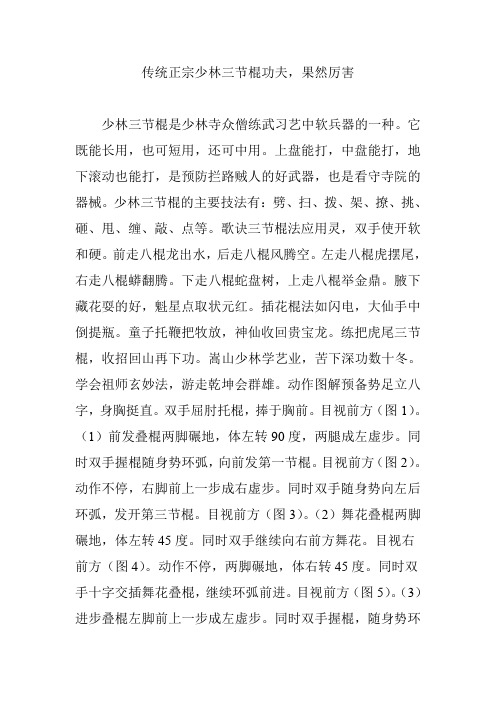
传统正宗少林三节棍功夫,果然厉害少林三节棍是少林寺众僧练武习艺中软兵器的一种。
它既能长用,也可短用,还可中用。
上盘能打,中盘能打,地下滚动也能打,是预防拦路贼人的好武器,也是看守寺院的器械。
少林三节棍的主要技法有:劈、扫、拨、架、撩、挑、砸、甩、缠、敲、点等。
歌诀三节棍法应用灵,双手使开软和硬。
前走八棍龙出水,后走八棍风腾空。
左走八棍虎摆尾,右走八棍蟒翻腾。
下走八棍蛇盘树,上走八棍举金鼎。
腋下藏花耍的好,魁星点取状元红。
插花棍法如闪电,大仙手中倒提瓶。
童子托鞭把牧放,神仙收回贵宝龙。
练把虎尾三节棍,收招回山再下功。
嵩山少林学艺业,苦下深功数十冬。
学会祖师玄妙法,游走乾坤会群雄。
动作图解预备势足立八字,身胸挺直。
双手屈肘托棍,捧于胸前。
目视前方(图1)。
(1)前发叠棍两脚碾地,体左转90度,两腿成左虚步。
同时双手握棍随身势环弧,向前发第一节棍。
目视前方(图2)。
动作不停,右脚前上一步成右虚步。
同时双手随身势向左后环弧,发开第三节棍。
目视前方(图3)。
(2)舞花叠棍两脚碾地,体左转45度。
同时双手继续向右前方舞花。
目视右前方(图4)。
动作不停,两脚碾地,体右转45度。
同时双手十字交插舞花叠棍,继续环弧前进。
目视前方(图5)。
(3)进步叠棍左脚前上一步成左虚步。
同时双手握棍,随身势环弧,十字叠手舞花,继续前进。
目视右侧(图6)。
动作不停,双手继续环弧舞花前进。
目视右侧(图7)。
动作不停,右脚前上一步成左高虚步。
双手握棍,随身势前进的同时,继续环弧向前抡转。
目视前方(图8)。
(4)单手插花左手脱把,展于左后上侧,掌心向外,掌指斜向上。
同时右手单棍,继续向左右两侧,环弧抡转于头前上方。
目视前方(图9)。
(5)叶下藏花两脚碾地,体左转180度,左手接棍,双手握棍,随身势左转的同时,继续环弧抡转于头上前方。
目视右前方(图10)。
动作不停,左脚前移成左弓步。
同时双手握棍,由右后上方向下向左,十字手环弧抡转于左腋下后侧。
九阴真经少林功夫好不好?少林功夫详解

九阴真经少林功夫好不好?少林功夫详解
我们为大家收集整理了关于九阴真经少林功夫好不好,以方便大家参考。
少林属于刚直的路子,招式大开大合,具有不错的控制能力和连招性。
套路定位是近战缠斗、群体控制、易被风筝、空战较弱
禁地:少林因其控制能力和部分强仇恨技能,可在禁地中作为引怪拉怪的最佳门派,其他门派的群控能力与其仍有一些距离,在特殊内功(被动回血)搭配下,少林可单刷禁地。
武学:少林功夫刚硬,在目前测试时期的有三个套路
【套路一】太祖长拳:简单易用,有很强的爆发力、控制能力以及独特虚招控制(破防摔倒);
攻击能力:4星
防御能力:3星半
恢复能力:1星
操作难度:3星。
少林功夫

少林功夫是指在嵩山少林寺这一特定佛教文化环境中历史地形成,以佛教神力信仰为基础,充分体现佛教禅宗智慧,并以少林寺僧人演练的武术为主要表现形式的传统文化体系。
少林功夫表现出来的深厚文化内涵是禅宗智慧赋予的。
少林功夫首先表现为一种信仰,一种对于超常神力的追求。
对于超常神力的渴望,对于超常智慧的追求,从来都是佛教徒的追求目标。
这是少林功夫表现为神奇的武术之根本原因,这也是少林功夫与其它武术区别所在。
少林功夫的灵魂是佛教禅宗智慧。
佛教徒非常重视愿力信仰对于修道过程的保障作用。
愿力信仰是少林功夫信仰一个重要的表现形态。
它形成于唐朝《妙法莲华经》盛行时期,一直延续至当代,经历了观世音菩萨信仰、那罗延执金刚神信仰、紧那罗王信仰三个阶段,是少林功夫信仰的主要形态。
少林功夫信仰主神叫紧那罗王神;少林寺有紧那罗王神殿。
少林功夫信仰的最初形态是禅定。
六世纪印度高僧菩提达摩在少林寺首传禅宗教法,后世尊少林寺为禅宗祖庭。
禅宗是印度佛教文化传入中国后,与中国玄学文化充分交流、理解的成果,是东方古代两大文明融合的结晶。
禅宗充满东方智慧对人生的洞彻。
禅宗教派的产生,使佛教原有的面对死亡悲苦之面貌,变为对人间生之欢乐的肯定。
禅宗,凝结着由中国历代高僧大德和优秀士大夫所构成的精英群体对于宇宙奥秘、人生真谛的体验和感悟。
唐、宋以来,由于禅宗教法的盛行和少林寺的祖庭地位,少林功夫的信仰内容和品质亦发生了变化,“禅武合一”开始成为少林功夫主流思想,并成为僧人修习少林功夫的目标和理想境界。
禅宗讲究在现实的日常生活中修行,实现学佛的目标。
少林功夫作为少林寺僧人日常生活的组成部分,也被纳入到学佛修禅的形式中。
修习少林功夫的主体是禅者,禅心运武,透彻人生,内心无碍无畏,表现出大智大勇的气概。
禅,赋予了少林功夫更为丰富的内容。
少林功夫表现出特有的轻松、自在、神化之境界。
佛教僧人的生活受佛教戒律的约束。
戒律体现佛教“慈悲为怀,普渡众生”的宗旨,是宗教徒的生活准则。
少林功夫绝技---铁板桥对你的腰特别好
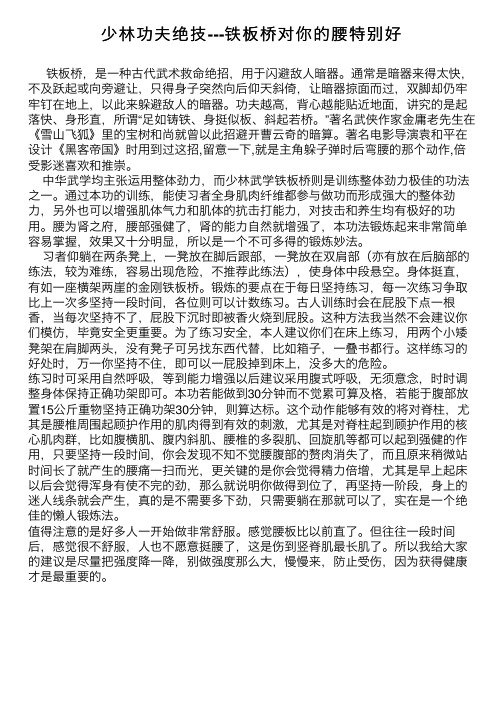
少林功夫绝技---铁板桥对你的腰特别好铁板桥,是⼀种古代武术救命绝招,⽤于闪避敌⼈暗器。
通常是暗器来得太快,不及跃起或向旁避让,只得⾝⼦突然向后仰天斜倚,让暗器掠⾯⽽过,双脚却仍牢牢钉在地上,以此来躲避敌⼈的暗器。
功夫越⾼,背⼼越能贴近地⾯,讲究的是起落快、⾝形直,所谓“⾜如铸铁、⾝挺似板、斜起若桥。
”著名武侠作家⾦庸⽼先⽣在《雪⼭飞狐》⾥的宝树和尚就曾以此招避开曹云奇的暗算。
著名电影导演袁和平在设计《⿊客帝国》时⽤到过这招,留意⼀下,就是主⾓躲⼦弹时后弯腰的那个动作,倍受影迷喜欢和推崇。
中华武学均主张运⽤整体劲⼒,⽽少林武学铁板桥则是训练整体劲⼒极佳的功法之⼀。
通过本功的训练,能使习者全⾝肌⾁纤维都参与做功⽽形成强⼤的整体劲⼒,另外也可以增强肌体⽓⼒和肌体的抗击打能⼒,对技击和养⽣均有极好的功⽤。
腰为肾之府,腰部强健了,肾的能⼒⾃然就增强了,本功法锻炼起来⾮常简单容易掌握,效果⼜⼗分明显,所以是⼀个不可多得的锻炼妙法。
习者仰躺在两条凳上,⼀凳放在脚后跟部,⼀凳放在双肩部(亦有放在后脑部的练法,较为难练,容易出现危险,不推荐此练法),使⾝体中段悬空。
⾝体挺直,有如⼀座横架两崖的⾦刚铁板桥。
锻炼的要点在于每⽇坚持练习,每⼀次练习争取⽐上⼀次多坚持⼀段时间,各位则可以计数练习。
古⼈训练时会在屁股下点⼀根⾹,当每次坚持不了,屁股下沉时即被⾹⽕烧到屁股。
这种⽅法我当然不会建议你们模仿,毕竟安全更重要。
为了练习安全,本⼈建议你们在床上练习,⽤两个⼩矮凳架在肩脚两头,没有凳⼦可另找东西代替,⽐如箱⼦,⼀叠书都⾏。
这样练习的好处时,万⼀你坚持不住,即可以⼀屁股掉到床上,没多⼤的危险。
练习时可采⽤⾃然呼吸,等到能⼒增强以后建议采⽤腹式呼吸,⽆须意念,时时调整⾝体保持正确功架即可。
本功若能做到30分钟⽽不觉累可算及格,若能于腹部放置15公⽄重物坚持正确功架30分钟,则算达标。
这个动作能够有效的将对脊柱,尤其是腰椎周围起顾护作⽤的肌⾁得到有效的刺激,尤其是对脊柱起到顾护作⽤的核⼼肌⾁群,⽐如腹横肌、腹内斜肌、腰椎的多裂肌、回旋肌等都可以起到强健的作⽤,只要坚持⼀段时间,你会发现不知不觉腰腹部的赘⾁消失了,⽽且原来稍微站时间长了就产⽣的腰痛⼀扫⽽光,更关键的是你会觉得精⼒倍增,尤其是早上起床以后会觉得浑⾝有使不完的劲,那么就说明你做得到位了,再坚持⼀阶段,⾝上的迷⼈线条就会产⽣,真的是不需要多下劲,只需要躺在那就可以了,实在是⼀个绝佳的懒⼈锻炼法。
少林派的著名功夫秘籍有哪些

少林派的著名功夫秘籍有哪些下面是专门为您整理好的:少林派的功夫秘籍。
少林派的功夫秘籍一:拳法1、少林罗汉拳:罗汉拳和金刚掌同为少林入门功夫,但修习到高深境界,最普通的拳掌亦能成为最厉害的武功。
正印证了“大智若愚,无巧不拙的千古道理。
2、光明拳:当年五大门派集会黄山,我佛光明拳在天都峰大展神威,夺得“天下第一拳美誉,可惜如今已不幸失传。
3、闯少林三十三路神拳:4、偏花七星拳:绝招是“七星聚会。
5、左右穿花手:6、少林双圈手:7、大摔碑手:8、波罗密手:又称少林风云手。
少林派的功夫秘籍二:掌法9、大力金刚手:金刚掌是少林寺基本武功之一。
10、般若禅掌:有“少林第一掌之称。
11、韦陀掌:有“灵山礼佛、“恒河入海等招数。
12、少林神掌八打:有分解掌、封闭掌、裂心掌等八种。
13、千手如来掌:14、大慈大悲千叶手:15、少林龙旋掌:16、少林散花掌:掌风推动落下的花瓣攻向敌人。
类似于“飞花摘叶的功夫。
17、少林握石掌:即少林绵掌,轻轻握石而化石为粉。
18、一拍两散掌:少林派的功夫秘籍三:指法19、澄静指:以静制动,后发制人。
20、摩柯指决:绝招是“三入地狱。
21、去烦恼指:绝招是“无忧无虑。
22、多罗叶指:十指轮弹,如波罗花绽开。
23、无相劫指:佛家无色无相的最高境界。
24、拈花指:迦叶尊者拈花微笑状。
25、大智无定指:源自《大智度经》。
26、一指禅功:被称为“少林第一指,能隔空伤人。
需有深厚的铁指禅劲功夫为基础。
27、铁指禅劲:一指禅的基础内功,练到登峰造极时五指可随意插入石碑之中。
38、慈悲刀法:名为慈悲,即慈悲为怀,这套刀法招式柔和,没有杀招,与破戒刀相反。
39、燃木刀法:少林派的功夫秘籍八:杖法40、伏魔铲法:41、普门杖法:戒律院用来惩戒触犯寺规的僧人的一种杖法,招式巧妙,临敌时总能招招命中对方。
但威力一般。
42、大文殊杖法:43、达摩八法神禅杖法:少林派的功夫秘籍九:棍法44、小夜叉棍法:绝招是“维护众生界,源自《维摩经》。
少林功夫与武术文化

少林功夫与武术文化中国传统武术文化源远流长,其中最著名的代表之一是少林功夫。
作为中国武术的代表之一,少林功夫体现了中国文化的深远影响力。
通过少林功夫的研究,我们可以深入探究中国文化,其中包括其哲学、宗教、艺术、历史等多个方面。
少林功夫的起源可以追溯到1500多年前的中国北魏时期。
当时,印度传教士传授了佛教和瑜伽的技术给中国,这些技术最终发展为了少林寺的武术。
少林寺位于中国河南省登封市嵩山下,是中国最著名的寺庙之一。
少林寺武术以其高度的战斗技能、内敛的哲学原则以及对身心技巧的强调而著名,并且它也是中国武术的重要发源地之一。
少林功夫对中国文化的贡献在于其倡导的精神原则。
它强调日常生活中的练习和修行,以及在战斗中表现的勇气和毅力。
其格言“血肉模糊埋忠骨,生死关头彰信条”就是体现了这种信念。
因此,它不仅仅是“拳头上的武术”,也是一种哲学和精神文化。
通过少林功夫,我们可以理解中国为什么注重于修身养性和自我完善。
此外,少林功夫的独特魅力亦使其受到了全球范围内的认可和社会、文化影响力。
自20世纪以来,少林功夫已成为一种全球性的旅游资源,吸引人们前往中国体验这种文化。
全世界都有数百万的少林功夫爱好者,并且有多个国家开设了少林武术学校。
全明星的电影和电视节目,也顺利地把少林功夫带进卡梅隆的电影,以及各类游戏和漫画作品中。
除此之外,少林局修行的传统将武术与哲学紧密结合在一起。
达到少林文化内涵深度,主要依赖菩提心和智慧。
在具有高强度的实用性和身体效果的同时,少林功夫也有着修身养性的内涵,能够帮助人们保持身心健康并最终实现自我完善。
因此少林功夫不仅是一件很好的健身工具,更是一种美好的生活方式。
总之,少林功夫作为中国武术文化的一个代表,给全人类带来了许多历史深度、思想高度、审美广度和价值深度,其深远的影响也离不开实践和宣传。
虽然现代社会的武术文化面临着严峻的挑战,但由于武术所具有的多种价值和作用,即便是千帆过尽的今天,少林武术也必定能取得再次壮大和发展。
少林功夫图解

少林功夫图解1.立山靠对方若上右步出右直拳击我胸部,我即速转身,上左步,左手同时托架其右肘部,右手屈肘变掌收抱于胸前(图1)。
勿停,左手即以掌中为中心,以对方肘尖为轴,迅速向外拧转推架其臂,左脚同时上半步。
左转体,左掌顺已臂下推,击向对方右肋或胸部(图2)。
要点:右掌推击与左手拧转、转体须协调一致,转体以腰为轴,左脚上步亦可上大步。
2.切掌对方若用右手抓握住我击出的右腕,我左手即出,立时按其右手背,身右转,左足疾向对方右腿后上步,锁住其足跟处,右手掌以缠腕法,带其小臂外旋,压住其手腕(图3),左手随即松开,以掌外沿为力点向左推击对方小臂,同时重心下移成马步式助力,令其向后跌出(图4)。
要点:抓握、转身上步、推击动作要连续进行,左手推击时要用爆发力。
3.架弓掌当对方进右步,用右掌横击我左耳根或左面部时,我迅速向左下方俯身,避其夹手,左手随即反臂用掌根插顶对方右腋下,肘尖向上同时顶架其臂肘弯处,左脚疾速上步达其身后(图5)。
勿停,左手向上转,推击对方胸部,右手护住胸前(图6),防其左手来攻。
要点:左掌架顶时,进击位置要准,推击要猝猛,臂伸直。
4.捌子腿对方若用右拳击我胸部,我左手即向右拨挡其右肘,同时右转,右手变掌向右随之转动,直臂由后向上,向左前方环绕后,身又稍右转,右掌举至左肩前,右脚即向对方右脚外侧上高虚步(图7)。
勿停,即以右手掌外沿为力点,斜砍对方后颈部(图8)。
要点:以上各动作均应协调一致,砍掌要狠。
5.双拨架击掌当对方出右直拳击我胸部时,我左手立即向左拨挡来手,即上左步(图9)。
勿停,对方一击未逞,改用左掌击我面部。
我抱于腰间之右拳即变掌,向右拨挡来手(图10),左掌疾速推向对方胸部(图11)。
要点:左右拨挡和推击须连续进行,侧身以腰为轴,左手推击要出其不意,用寸劲。
6.闪身双推掌对方若进右步,出右拳击我胸部,我迅即右闪身,右脚同时向右前方上步,两手立时屈肘变掌由下向上举至胸前,闪避来手(图12)。
强大的少林武功精髓详细介绍(图文)

辛卯贰零壹壹年【兔年】少林功夫一指禅少林武术在其漫长发展过程中,经过历代少林高手的不断演练,逐步成为博大精深的武术流派。
这主要表现为:一是内容广博;二是风格独异,少林武术的内容,按其性质可分为内功、外功、轻功、气功、硬功等,按技法有分为拳术、枪术、刀术、剑术、棍术、技击等百余种。
倒挂金钟少林武术总的特点是刚劲有力,朴实无华,变化无穷,利于实战。
其拳术,重技击,演练起来不受场地限制,即所谓“拳打卧牛之地”。
少林拳的起、落、进、退、反、侧、收、纵都在一条线运动,故有“拳打一条线”之说,拳术的手法曲而不曲,直而不直、过曲,欠一寸击之不中,过直,则力量较难回旋;拳术的出击方法滚出滚入,也就是说出拳时要产生旋转,使之富有弹性;眼法是起望眼,落望天,以目视目;身法是起横落顺,转动自如;步法是进步低,退步高,即抬腿轻如鸿毛,震脚重如泰山。
在使用方法上,少林拳内静外猛,即“守之如处女,犯之如猛虎。
”少林拳的整体动作内外合一,形神兼备。
其招招势势,非攻即守,攻中有守,守中有攻,虚虚实实,声东击西。
少林拳演练起来,秀如猫,斗如虎,行如龙,动如风,声如雷。
铁头少林武术中的兵器也各具特色。
少林的枪术,有劈、穿、点、挑、拨、扫、截等动作。
其特点是“枪似蛟龙,枪扎一条线”。
练枪时要求“扎枪如斗虎,出枪一条线,枪出如射箭,收枪如捺虎,挑枪如挑龙”。
少林刀术的特点是“刀如猛虎”。
其刀法多为缠头裹脑,翻身劈扫以及刺、捺、撩、砍、抛等。
少林的单刀、双刀、大刀有“单刀看手,双刀看走,大刀定手。
”之说。
少林剑演练起来优美豪放,故有“创若游龙”之说。
练少林剑时要求“走剑要平善,气要随剑走,两眼看剑尖,剑行如飞燕,剑落如停风,剑收如钢钉。
”棍术是少林武术最负盛名的兵器,当年少林寺十三武僧曾以棍助唐王击败王世充而闻名天下。
少林棍不仅内容广博,而且特点鲜明,少林棍练起来“棍打一大片”。
其一扫一劈,全身着力,呼呼生风,节奏快,棍法紧。
横踏壁行禅和拳本来是两个截然相反的形态,禅以静为其特征,拳以动为其特点。
少林功夫的起源以及学习少林功夫的好处
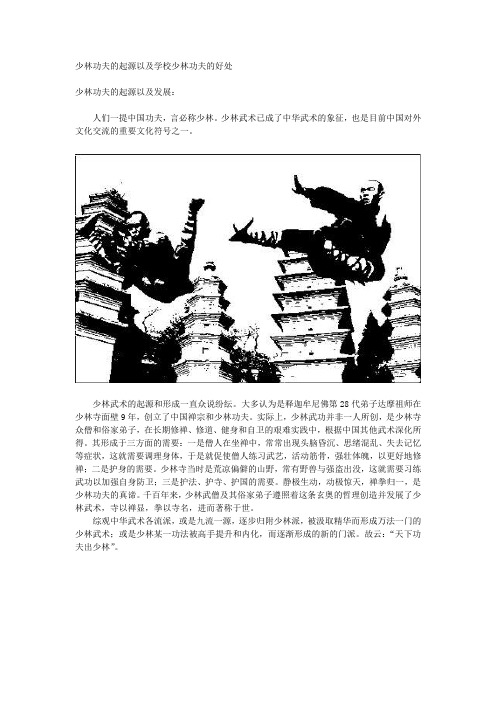
少林功夫的起源以及学校少林功夫的好处少林功夫的起源以及发展:人们一提中国功夫,言必称少林。
少林武术已成了中华武术的象征,也是目前中国对外文化交流的重要文化符号之一。
少林武术的起源和形成一直众说纷纭。
大多认为是释迦牟尼佛第28代弟子达摩祖师在少林寺面壁9年,创立了中国禅宗和少林功夫。
实际上,少林武功并非一人所创,是少林寺众僧和俗家弟子,在长期修禅、修道、健身和自卫的艰难实践中,根据中国其他武术深化所得。
其形成于三方面的需要:一是僧人在坐禅中,常常出现头脑昏沉、思绪混乱、失去记忆等症状,这就需要调理身体,于是就促使僧人练习武艺,活动筋骨,强壮体魄,以更好地修禅;二是护身的需要。
少林寺当时是荒凉偏僻的山野,常有野兽与强盗出没,这就需要习练武功以加强自身防卫;三是护法、护寺、护国的需要。
静极生动,动极惊天,禅拳归一,是少林功夫的真谛。
千百年来,少林武僧及其俗家弟子遵照着这条玄奥的哲理创造并发展了少林武术,寺以禅显,拳以寺名,进而著称于世。
综观中华武术各流派,或是九流一源,逐步归附少林派,被汲取精华而形成万法一门的少林武术;或是少林某一功法被高手提升和内化,而逐渐形成的新的门派。
故云:“天下功夫出少林”。
少林武术依前人所传达三百六十余门,另一说法为七百余种,有些已失传,目前仍流传的有一百多种。
主要内容有:易筋经、童子功、器械、轻气功、硬气功、擒拿格斗、散打搏击、72艺和防止运动创伤、少林骨伤科防治技术和少林治伤秘诀等。
目前,少林武术分为传统武功和竞技武功,其中,传统武功为其精华。
传统武功又分为“功夫”、“拳法”两部分。
功夫旨在练气练力,为强身健体之术,克敌制胜之本。
如“心意把”、“少林十三趟金刚把”、“少林罗汉十八手”、“少林六合拳”等。
拳法为临战时防卫、技击大法则。
如“少林罗汉拳”、“通臂拳”等。
其中,又以少林拳术为典型代表,其特点是刚健有力、刚中有柔、朴实无华、利于实战,招招式式非打即防,没有花架子,不受场地限制,有“拳打卧牛之地”之说。
禅武合一——少林功夫(连载三)

旋转 中 的 进 攻 也
。
可 以 随时 攻 防结合
身形 的 滚 出
滚入 先
,
,
起横 落顺
,
。
起 势 以正 身为
。
横进 横 退
利 于 进 退 速度
,
落势 以侧 身为后
积
,
缩小攻 击面
有 利 于 防守
。
身形 的起横 落
lI顷 形 成 了 拧 身滚 动 的 滚 出滚 入
,
运 动 身形 的 滚动
,
使对方 难 以捕
。
防 露
,
既 避 免手 臂直 伸
,
以演 练 少林 功 夫
练场地
一
少林 功 夫 的 演
与其有着 密切 的 关 系
尤 其是 由
,
,
易受侵 击
,
,
影 响 收避
。
又避
一
般 是在
一
个长 约 六 米
,
佛教戒律 为基 础 的 习 武 戒 约
对
免手臂 太 曲
一
出手无 力
发
拳
宽 约 半 米 的长 方 形 区 域 内进 行
合 戈
一
少 术
三 少 林功 夫 的 技术 表
、
: 动
!
,
左 少林 功 夫 的套路讲 究
‘
向左 推 拦 护至
进招
一
条线
” ,
指 少林 功 夫
复预 备
个 动 作和 套路 从 起 势 到 收彗
的起
、
落
、
进
、
退
、
闪
、
佛 教 文 史 肇仲教 叉 百忑 ●可 可 蔼 五瑟 蕊
武术少林功夫教案

武术少林功夫教案教案标题:武术少林功夫教案一、教学目标:1. 知识目标:- 了解武术少林功夫的起源、特点与意义。
- 掌握基本的武术姿势、动作和技巧。
- 熟悉少林拳法中的套路和器械。
2. 能力目标:- 培养学生的反应能力、协调性和灵活性。
- 培养学生的自信心、合作意识和自我保护能力。
3. 情感目标:- 培养学生对少林文化的兴趣和热爱。
- 培养学生的自律、坚韧和尊重他人的品质。
二、教学重点和难点:教学重点:掌握基本的武术姿势、动作和技巧。
教学难点:培养学生的自我保护能力和合作意识。
三、教学准备:1. 教具准备:- 少林功夫教材/视频资料。
- 座椅和投影仪(用于展示教材/视频)。
- 武术器械(如:长棍、鞭、刀等)。
2. 环境准备:- 教室内空间要宽敞,避免地面有滑倒的物品。
- 根据学生人数和器械使用情况,保证教学区域的安全。
四、教学步骤:1. 引入(约5分钟):- 讲述少林功夫的起源、发展和文化意义,激发学生对功夫的兴趣。
- 播放少林功夫的相关视频资料,展示其高强度、灵活性和艺术性。
2. 知识讲解(约10分钟):- 介绍基本的武术姿势,如马步、站桩、握拳等。
- 对比不同的武术招式,讲解正确的动作和技巧。
3. 基本技巧练习(约15分钟):- 分组进行基本技巧的练习,如拳法基本动作、脚法基本动作等。
- 强调动作的标准姿势和力度,指导学生进行反复训练。
4. 合作练习(约15分钟):- 将学生分成小组,进行合作练习。
- 引导学生学习合作、协调和互相支持,通过练习套路和对练等活动。
5. 武术器械体验(约15分钟):- 引导学生了解不同的武术器械,如长棍、鞭、刀等。
- 分组进行器械的体验练习,注意安全操作和保护措施。
6. 总结与展示(约5分钟):- 邀请学生进行表演展示,展示所学的武术动作和技巧。
- 总结今天的教学内容,并鼓励学生坚持练习,培养自我保护能力和健康意识。
五、教学评估:1. 观察学生在基本技巧练习中的表现,评估其对基本动作和技巧的掌握程度。
《少林功夫》教案
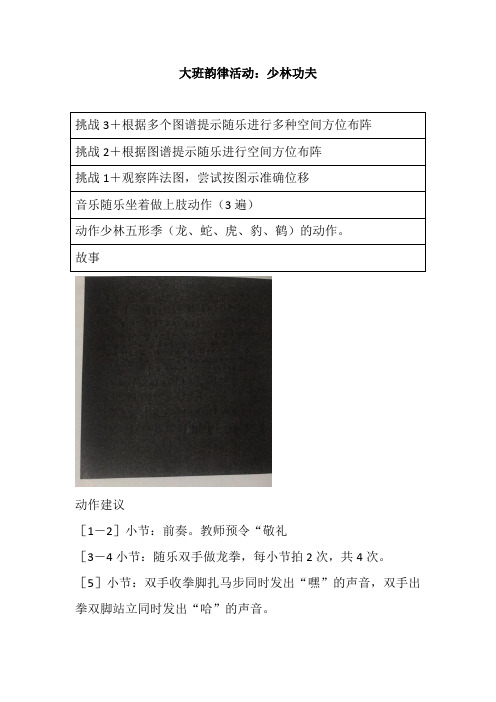
大班韵律活动:少林功夫挑战3+根据多个图谱提示随乐进行多种空间方位布阵挑战2+根据图谱提示随乐进行空间方位布阵挑战1+观察阵法图,尝试按图示准确位移音乐随乐坐着做上肢动作(3遍)动作少林五形季(龙、蛇、虎、豹、鹤)的动作。
故事动作建议[1-2]小节:前奏。
教师预令“敬礼[3-4小节:随乐双手做龙拳,每小节拍2次,共4次。
[5]小节:双手收拳脚扎马步同时发出“嘿”的声音,双手出拳双脚站立同时发出“哈”的声音。
[6]小节:踏步。
[7-8]小节:随乐双手做蛇拳,每小节拍2次,共4次。
[9]小节:双手收拳脚扎马步同时发出“嘿”的声音,双手出拳双脚站立同时发出“哈”的声音。
[10]小节:踏步[11-12]小节:随乐双手做虎拳,每小节拍2次,共4次。
[13]小节:双手收拳脚扎马步同时发出“螺”"的声音,双手出挙双脚站立同时发出“哈”的声音。
[14]小节:踏步。
[15-16]小节:随乐双手做豹拳,每小节拍2次,共4次。
[17]小节:双手收拳脚扎马步同时发出“嘿”的声音,双手出拳双脚站立同时发出“哈”的声音。
[18]小节:踏步。
[19-20]小节:随乐双手做鹤拳,每小节拍2次,共4次。
[21]小节:双手收拳脚扎马步同时发出“嘿”的声音,双手出拳双脚站立同时发出“哈”的声音。
[22]小节:踏步。
活动目标1、感受中国风音乐和中华武术的精神,合拍表现音乐结构及少林拳法的动作。
2、通过观察模仿学习少林五形拳的基本动作,借助图谱的提示布阵。
3、在“布阵法”游戏中锻炼偷快接受挑战的信心和胆量,并做到团结协作、快速反应。
活动准备经验准备:观看少林功夫视频物质准备:ppt,音乐。
活动过理一、谈话导入孩子们,你们看老师穿了一套什么服装?(少林武术服),今天我是少林师父,你们看看这是哪里呢?(少林寺大门),想进到少林寺学武功吗?今天师父教你们一套五形拳,学会了这套拳就能进入少林寺,请你们仔细看看这套拳法中表现了哪五种动物?二、熟悉乐曲结构,倾听乐曲,感知五形挙动作。
《少林功夫》歌词 徐小凤
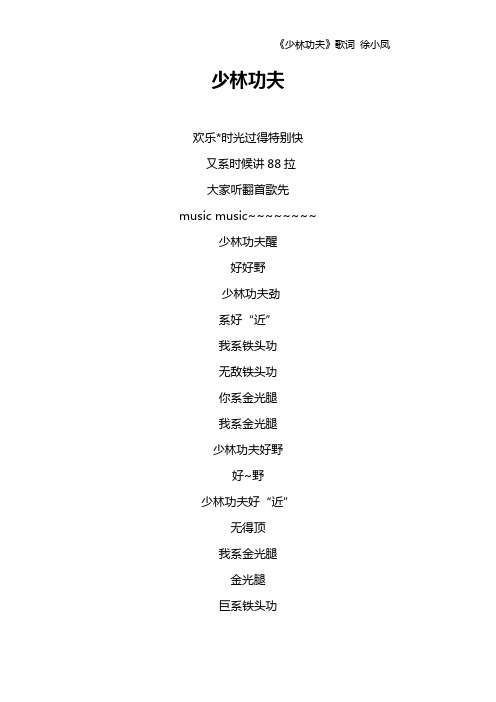
少林功夫
欢乐*时光过得特别快
又系时候讲88拉
大家听翻首歌先music music~~~~~~~~
少林功夫醒
好好野
少林功夫劲
系好“近”
我系铁头功
无敌铁头功
你系金光腿
我系金光腿
少林功夫好野
好~野
少林功夫好“近”
无得顶
我系金光腿
金光腿
巨系铁头功
哇蛙~~~~~~~~~~ 唱歌唱都喊惊甘
唱咩啊
D歌词又鬼5马6 我啊一秒都听吾明白
米系罗
D歌词边个作架
边个作架
我罗
砰
哎呀
music~~~~~~~~
少林功夫醒
好好野
少林功夫劲
系好
“近”
我系铁头功
无敌铁头功
你系金光腿
我系金光腿
少林功夫好野
好~野
少林功夫好“近”
吾得顶
我系金光腿
金光腿
巨系铁头功
哇蛙~~~~~~~~~~
******~~~~~~~~~~~~~~~~~~~~~~~~~~~~~~~ 以上就是关于少林功夫的歌词,感谢您的阅读!。
少林武术的介绍

少林武术的介绍下面是专门为您整理好的:少林功夫的介绍。
少林寺武术缘起于中国远古祖先的生产劳动。
人们在狩猪的生产活动中,逐渐积累了劈、砍、刺的技能,这些原始形态的攻防技能就是少林寺武术技术形成的基础。
少林武术萌芽于原始社会时期。
氏族公社时代,经常发生部落战争,因此在战场上搏斗的经验促进了少林寺武术的萌芽。
少林寺武术成形于奴隶社会时期。
夏朝建立后,经过连绵不断的战火,少林寺武术为了适应实战的需要进一步向实用化、规范化发展。
商周时期,产生了太极学说,从此奠定了少林寺武术的体系。
少林寺派功夫代表潘国静少林寺武术发展于封建社会时期。
秦汉时,盛行角力、击剑,还有“刀舞、“力舞等。
唐朝时开始实行武举制,对少林寺武术的发展起到了很大的促进作用。
宋元时期,以民间结社的武艺组织为主体的民间练武活动蓬勃兴起。
明清时期则是少林寺武术的大发展时期,流派林立,拳种纷显,形成了太极拳、形意拳、八卦拳等主要的拳种体系。
到了近代,少林寺武术逐步成为中国近代体育的有机组成部分。
1927年,在南京成立了中央少林寺武术馆。
少林寺武术学校是唯一正宗河南嵩山少林寺招生,嵩山少林寺正宗少林功夫传人永帝大师亲自收徒,传授正宗河南少林寺武术.为嵩山少林寺学员限额对外招生.河南少林寺招生电话0371-651788821936年中国少林寺武术队赴柏林奥运会参加表演中华人民共和国成立后,少林武术得到了蓬勃发展。
1999年,国际武联被吸收为国际奥委会的正式国际体育单项联合会成员,意味着少林寺武术即将成为奥运项目,意味着“把少林寺武术推向世界的雄伟目标的进一步实现!因而两仪功法制人而不伤人,有一拳制人之威,又有一掌复原之能,堪称武林一绝。
少林寺武术如同浩瀚大海,深不可测,门派拳种,枝繁叶茂,穷毕业生精力能得其九牛二虎之一毛,已属不易。
整理本文的目的,是为了使武术爱好者对中国武术有一个全面的认识和了解。
坦率的说,由于武术的神秘性,不可能将所有门派(拳种)概括于本文之中。
- 1、下载文档前请自行甄别文档内容的完整性,平台不提供额外的编辑、内容补充、找答案等附加服务。
- 2、"仅部分预览"的文档,不可在线预览部分如存在完整性等问题,可反馈申请退款(可完整预览的文档不适用该条件!)。
- 3、如文档侵犯您的权益,请联系客服反馈,我们会尽快为您处理(人工客服工作时间:9:00-18:30)。
A usual classification of contents about Quan 1. Basic skills (基本功): These include stamina, flexibility, and balance, which improve the body abilities in doing martial maneuvers. In Shaolin kung fu, flexibility and balance skills are known as "childish skills" (童子功), which have been classified into 18 postures. 2. Power skills (气功): These include: •Qigong meditation: Qigong meditation itself has two types, internal (内), which is stationery meditation, and external (外), which is dynamic meditation methods like Shaolin four-part exercise (si duan gong), eight-section brocade (八段锦), Shaolin muscle-changing scripture (易筋经), and others. •The 72 arts: These Include 36 soft and 36 hard exercises, which are known as soft and hard qigong. 3. Combat skills (拳法) skills: These include various barehanded, weapon, and barehanded vs. weapon routines (styles) and their combat (散打) methods.
Chan Buddhism introduced a optimistic climate with an affirmation of the deep joy to be found in life. Chan Buddhism clearly reflects the depth of experience and penetration into the mysteries of the universe. Chan Buddhism pays special attention to achieving the goal of Buddhism via the daily cultivation according to the strict precepts and religious doctrines(教 义).
List of known styles
•Arhat's 18 hands (罗汉十八手): known as the oldest style.
•Flood style (洪拳): with the small form (小洪拳) known as the son of the styles, and the big form (大洪拳) known as the mother of the styles. •Explosive style (炮拳): known as the king of the styles. •Through-the-Arms style (通臂拳). •7-star & Long Guard the Heart and Mind Gate style (七星 & 长护心意门拳).
features
shaolin Kungfu is presented with the movement of the human body such as attack, defense and wrestling as its core and the series套路 as its basic units
The wisdom of Chan Buddhism has imparted profound cultural connotations to Shaolin Kungfu. The practice of Shaolin Kungfu should first be based on the belief of Buddhism including wisdom belief and strength belief. The First Patriarch Bodhidharma(菩提达摩) is revered as its deity( 神性)of wisdom and Kinnara(紧 那罗) as deity of strength. The aspiration for supernatural power and pursuit of supreme wisdom has always been the goals pursued by Buddhists. This is also the main reason for Kungfu’s mystical effects and distinguishes Shaolin Kungfu from other Kungfu.
•Shaolin temple has two main legacies: Chan (禅), which refers to Chan Buddhism, the religion of Shaolin, and Quan (拳), which refers to the martial arts of Shaolin. In Shaolin, these are not separate disciplines and monks have always pursued the philosophy of the unification of Chan and Quan (禅拳合一).
the medical knowledge of ancient China & the rule of movement of the human body. the combination of movement and stillness the balance between Yin and Yang, the complement of toughness and softness the inclusion of the spirit and the form.
"Six Harmonies", composed of the three external harmonies (shoulders and hip, elbows and knees, hands and feet) and the three internal harmonies (mind and intention, intention and Qi, Qi and force).
The inheritance of Shaolin Kung Fu
• Shaolin Kungfu is taught mainly by oral formulas handed down from
generation to generation. In history, the recognition of inheritors of Shaolin Kungfu was based on the patriarchal clan system of Shaolin temple. In the process of teaching and learning Shaolin Kungfu, it is necessary for masters to teach disciples(门徒,弟子)by personal example as well as oral instruction and for disciples to study diligently. The inheritance of high level Shaolin Kungfu always depends on the teaching and oral instruction of masters as well as disciples’spiritual comprehension of Chan Buddhism. To reach such level of Kungfu, monks have to improve themselves on both daily Chan studies and Kungfu practices. The idea behind Shaolin Kungfu is the belief in the combination of Chan and martial arts.
•Plum Blossom style (梅花拳).
•Facing&Bright Sun style (朝&昭 阳拳). •Arhat style (罗汉拳): known as the most representative style. •Vajrapani style (金刚拳).
•Emperor's Long-range style (太祖长拳): known as the most graceful style. •Guard the Home, aka Special, style (看家拳). •Chain Hands and Short-range combat (连手短打). •5 Combinations style (五合拳) •6-Match style (六合拳) •Soft style (柔拳) •Mind (心意拳) aka Confusing Path style (迷踪拳) •Imitative styles (象形拳) (including Dragon, Tiger, Leopard, Eagle, Monkey, Mantis, etc.). •Drunken style (醉拳).
